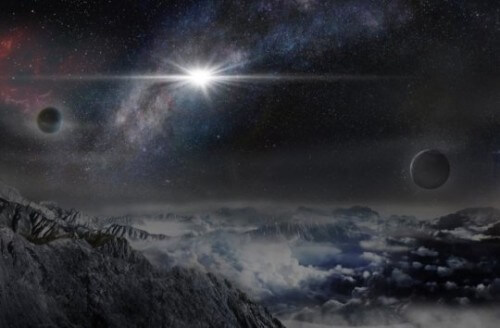Astronomers recently observed a giant ball of hot gas billions of light years away radiating the energy of hundreds of billions of suns. The diameter of the gas ball is about 15 kilometers. Astronomers are not sure what the cold phenomenon is. If, as they suspect, the glob of gas was formed as a result of a supernova, then this is the most powerful supernova ever observed

Astronomers recently observed a giant ball of hot gas billions of light years away radiating the energy of hundreds of billions of suns. The diameter of the gas ball is about 15 kilometers. Astronomers are not sure what the origin of the phenomenon is. If, as they suspect, the ball of gas was formed as a result of a supernova, then this is the most powerful supernova ever observed.
In this week's issue of the journal Science, the researchers reported that the object at the center of the explosion may be a rare type of star known as a magnetar, but so powerful that it pushes the limits of energy to the limit allowed by physics.
An international team of professional and amateur astronomers saw the suspected supernova now known as ASASSN-15lh when it first lit up in June 2015. One of the paper's lead researchers, Krzysztof Stanek, professor of astronomy at Ohio University, says: "If it is indeed a magnetar, it looks like nature has taken all What we know about magnets brought it to rank 11 out of 10.
The ball of gas surrounding the object cannot be seen with the naked eye because it is 3.8 billion light years away from us. But it was observed by the Automated Supernova Sky Scanner (ASAS-SN) operated by a partnership led by Ohio State University. The observation is made using a battery of small telescopes around the world looking for bright objects in our neighborhood in the universe.
Although ASAS-SN has detected about 250 supernovae since the survey began in 2014, the powerful explosion of ASASSN-15lh stands by orders of magnitude. It is 200 times more powerful than an average supernova. 570 billion times brighter than the Sun and 20 times brighter than all the stars in the Milky Way combined.
"We have to ask how this is possible" says Tank, "it takes a lot of energy to shine with such clarity, and that the energy has to come from somewhere."
"The honest answer is that at this point we don't know what might have been the power source of ASASSN-15lh," says Subo Dong, the lead researcher on the paper in Science and a professor of astronomy at Peking University.
He added that the discovery "may lead to new thinking and new observations of a new type of extremely luminous supernovae.
Todd Thompson, professor of astronomy at Ohio University, offers a possible explanation. The supernova may be the explosion of an extremely rare type of star known as a millisecond magnetar, a compact star that spins rapidly and has an extremely strong magnetic field.
To shine with such intensity, this particular magnetar would have to spin at least 1,000 times per second, converting all the rotational energy into light with nearly 100 percent efficiency, Thompson explained. This would be the most extreme example of a magnetizer that scientists believe is physically possible.
“Given these constraints,” he said, “could we ever see anything brighter than this? If it really is Magnetar, then the answer is actually no.”
The Hubble Space Telescope will help settle the question later this year, in part because it will allow astronomers to see the host galaxy surrounding the object. If the team finds that the object is at the center of a large galaxy, then it may not be a magnetar at all, and the gas around it is not evidence of a supernova, but the result of unusual nuclear activity around a supermassive black hole. Even in this case, the researchers say, it is something that has not yet been seen in the center of any galaxy.

6 תגובות
"It seems as if nature has taken everything and brought it..."
"It takes a lot of energy..."
"May lead to new thinking and sensitive observations of..."
15 km? What did I not understand here?
http://www.techtimes.com/articles/24444/20150103/large-asteroids-to-flyby-earth-in-january-through-march-should-humans-worry.htm
What about the asteroid that is supposed to approach the Earth on March 5, 2016?
Is there any news about it?
I saw a NASA simulation that the approach is critical to reach the height of the TV satellites
With a diameter of 50 meters, 2 times what crashed in Russia..
It seems that there is an error in specifying the diameter of the gas ball
Should be a different measure than 15 kilometers
This year we may be able to witness for the first time a supernova whose appearance can be predicted in advance.
The astronomers predict the "return" of the Refsdal supernova around April of this year, which due to the gravitational dusting of the light from it made an additional journey of several years and therefore it has already been observed more than once.
http://gizmodo.com/this-is-how-we-know-a-supernova-is-coming-in-2016-1743763465